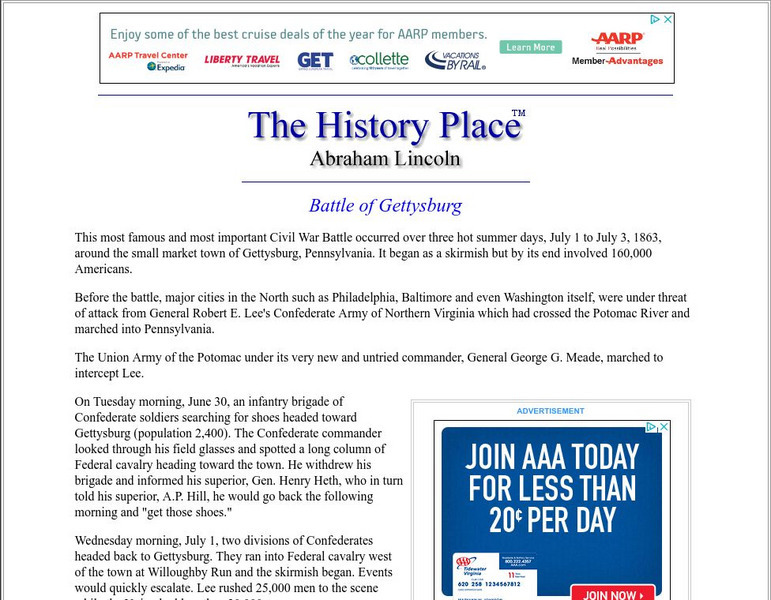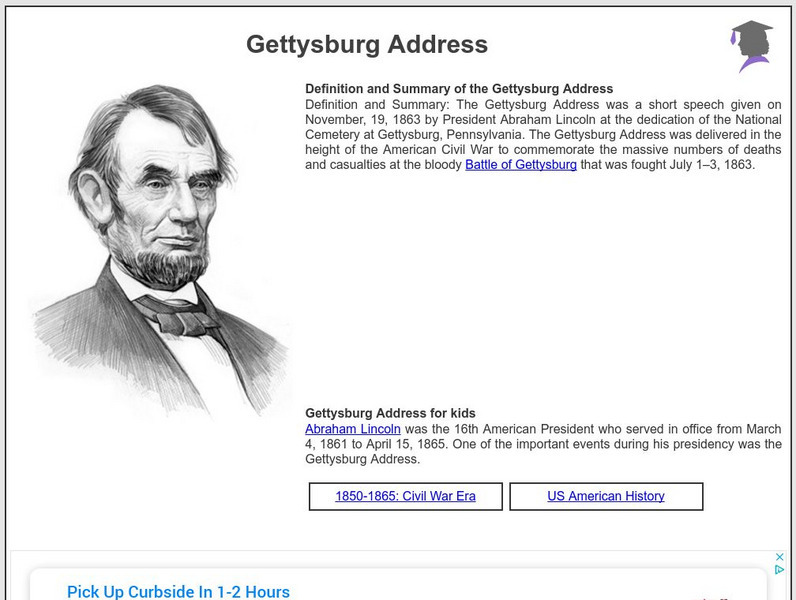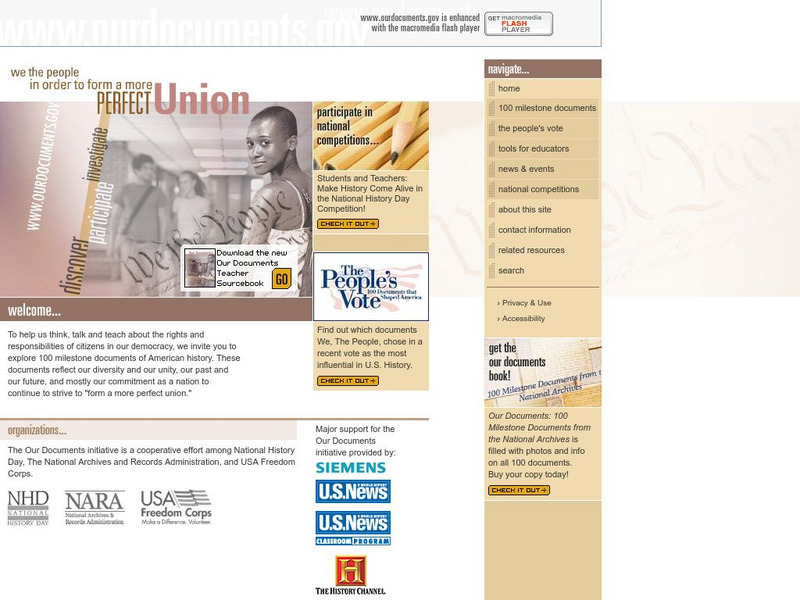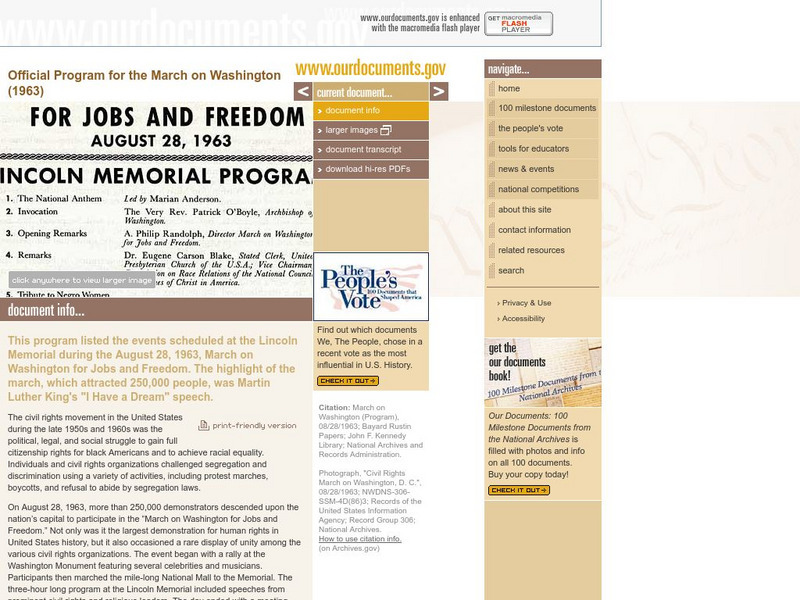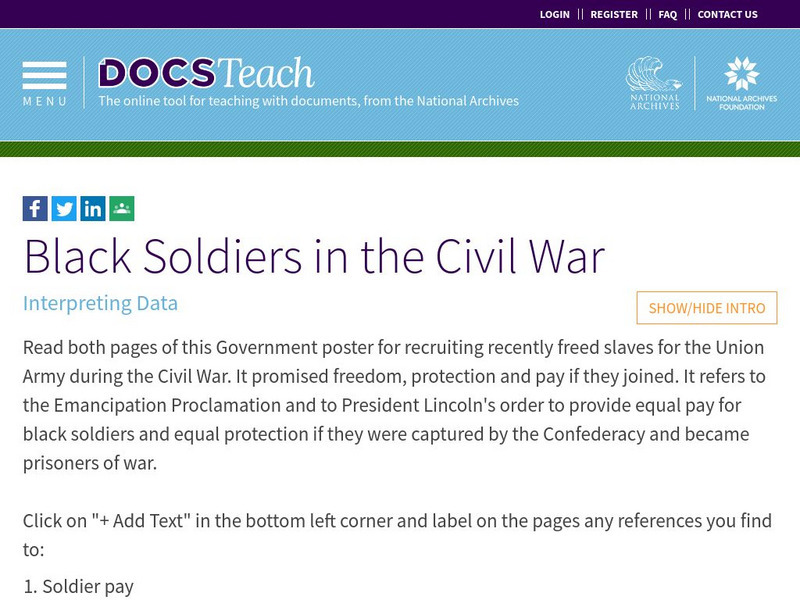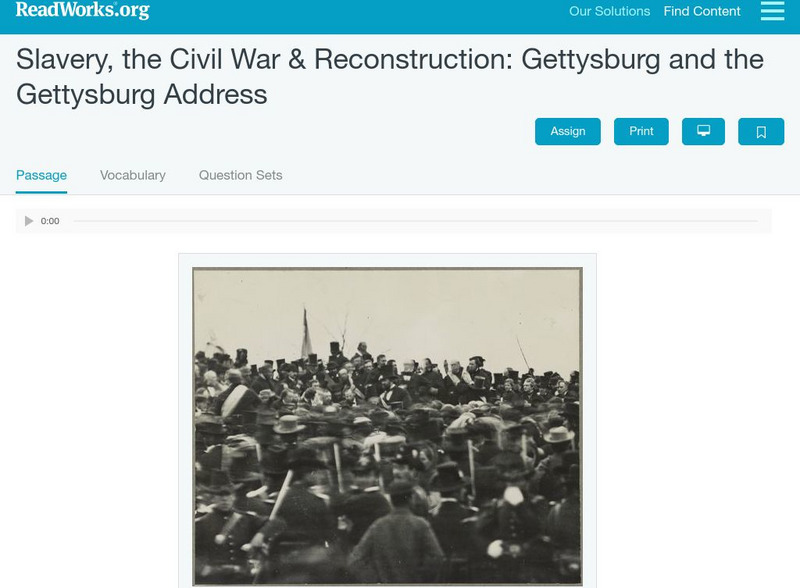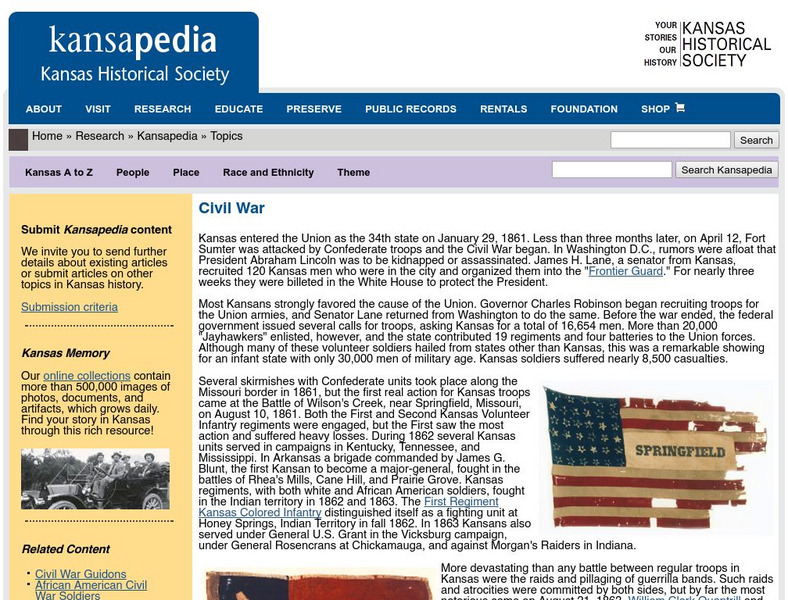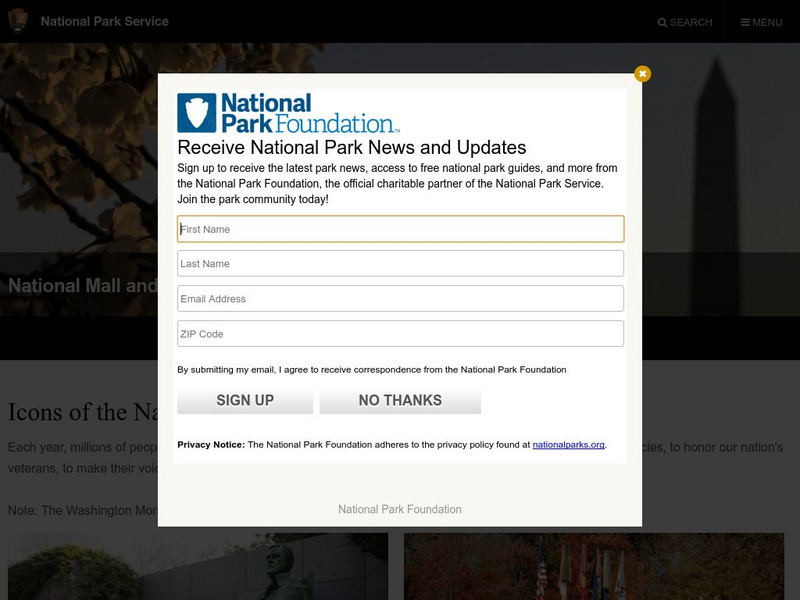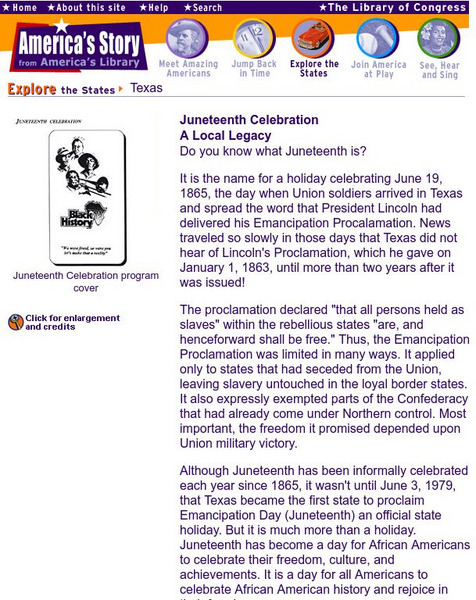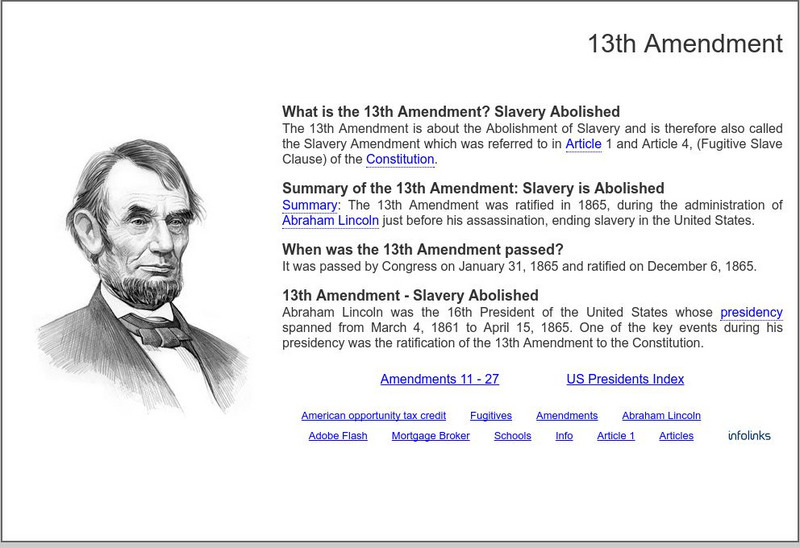The History Place
The History Place: Battle of Gettysburg
This site from The History Place provides a detailed account of the most famous and important battle of the U.S. Civil War, the battle of Gettysburg. Check out the link, near the bottom of the page, to a letter from President Lincoln to...
Siteseen
Siteseen: American Historama: Gettysburg Address
Provides interesting facts and important information about the Gettysburg Address commemorating the massive deaths at the bloody Battle of Gettysburg.
Mocomi & Anibrain Digital Technologies
Mocomi: Mount Rushmore Facts and History
Provides the history of Mount Rushmore with many interesting facts.
US National Archives
Nara: Teaching With Documents: The Treaty of Guadalupe Hidalgo (Activity)
The National Archives and Records Administration (NARA) provides a instructional activity, focusing on the treaty of Guadalupe Hidalgo, that relates to the power granted to the President and the Senate to make and approve treaties with...
Other
The Constitution of the State of Nevada
The complete text of the Nevada Constitution. The Nevada constitution of July 4, 1864 forbid slavery and allowed for President Lincoln to proclaim that the State of Nevada was admitted into the Union on an equal footing with the original...
US National Archives
Our Documents: A National Initiative on American History, Civics, and Service
Our Documents is home to one hundred milestone documents that influenced that course of American history and American democracy. Includes full-page scans of each document, transcriptions, background information on their significance, and...
US National Archives
Our Documents: Official Program for March on Washington(1963)
Contains a copy of the original program for the March on Washington that featured Martin Luther King. Provides a summary of the civil rights movement at that time.
Other
Active History: The American Civil War Simulation
Take on the role of President Jefferson Davis or President Abraham Lincoln and proceed through the Civil War. This simulation can be played between two players or one. Users are challenged to choose the courses that each president likely...
Smithsonian Institution
National Portrait Gallery: Zaida Ben Yusuf: Daniel Chester French
This site provides information about the sculptor Daniel Chester French. He is famous for his sculpture of President Lincoln created as a part of the Lincoln Memorial. The picture is provided by a photograph taken by Zaida Ben-Yusuf.
CommonLit
Common Lit: "A Nation Divided: North vs. South" by Us history.org
The American Civil War was fought within the United States from 1861 to 1865. The election of President Abraham Lincoln in 1860 increased tension between the North and South. Lincoln's political party was interested in stopping the...
University of Groningen
American History: Outlines: Industrial Growth
By 1860, when Abraham Lincoln was elected president, 16 percent of the population lived in urban areas and a third of the nation's income came from manufacturing. Funds were flowing into large-scale industrial development and into...
Other
Crisis at Fort Sumter
Detailed background information is provided to assist users in solving the dilemmas facing President Lincoln in the events surrounding the fall of Fort Sumter.
Other
Vox: 37 Maps That Explain the American Civil War
April 1865 was a momentous month in American history. On April 9, the Confederate army under Robert E. Lee surrendered to the Union forces of Ulysses S. Grant, effectively ending the Civil War. Then on April 14, the victorious President...
US National Archives
Docsteach: Black Soldiers in the Civil War
In this activity students will analyze a two-page poster that the Government used to recruit recently freed slaves to fight for the Union Army during the Civil War. The poster refers to the Emancipation Proclamation and to President...
US National Archives
Docsteach: What Else Was Happening During the Civil War Era?
The years leading up to, during, and following the Civil War and Reconstruction (1850-1877) are most often remembered for the tension between North and South, the question of slavery, President Lincoln, and social and political changes...
Read Works
Read Works: Slavery, the Civil War, and Reconstruction Gettysburg
[Free Registration/Login Required] An informational text about the Battle of Gettysburg and President Lincoln's Gettysburg Address. A question sheet is available to help students build skills in reading comprehension.
Kansas Historical Society
Kansas State Historical Society: Kansas in the Civil War
Read about the Kansas "Frontier Guard" that protected President Lincoln, and find out about one of the largest cavalry battles fought in the Civil War at the Battle of Mine Creek in Kansas.
Curated OER
National Park Service: National Mall
This site is from the National Park Service. No shoe stores at this mall! Find out about our national "front yard" -- statistics, a link to the history of the National Mall, and a listing of all the monuments on the Mall. Also includes a...
Library of Congress
Loc: America's Story: Juneteenth Celebration
This resource is a brief article about Juneteenth, or Emancipation Day, which celebrates the day when Union soldiers arrived in Texas and spread the word that slaves were free.
CommonLit
Common Lit: Last Diary Entry of John Wilkes Booth
A learning module that begins with "Last Diary Entry of John Wilkes Booth" by John Wilkes Booth, accompanied by guided reading questions, assessment questions, and discussion questions. The text can be printed as a PDF or assigned online...
Encyclopedia Britannica
Encyclopedia Britannica: David Hunter
This entry from Encyclopedia Britannica features David Hunter, a Union officer during the American Civil War who issued an emancipation proclamation (May 9, 1862) that was annulled by President Abraham Lincoln (May 19).
Siteseen
Siteseen: American Historama: Reconstruction Era
Covers the Reconstruction of the South after the Civil War from 1865-1877.
History Teacher
Historyteacher.net: The Civil War: Quiz (1)
This 10-question multiple choice quiz is immediately scored and tests your comprehension of slavery in the South leading up to the Civil War.
Siteseen
Siteseen: Government and Constitution: 13th Amendment
The 13th Amendment was passed by Congress on January 31, 1865, but not ratified until December 6, 1865. This article provides an explanation and summary of the 13th Amendment or Fugitive Slave Clause that abolished slavery.
Other popular searches
- President Lincoln
- President Abraham Lincoln
- Civil War President Lincoln
- President Lincoln Speeches
- Esl President Lincoln


